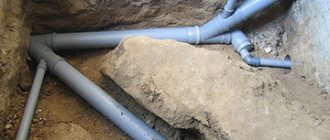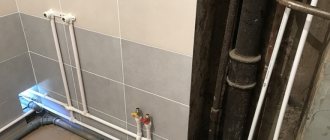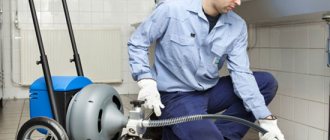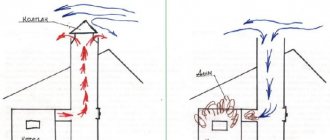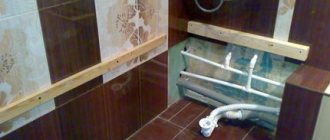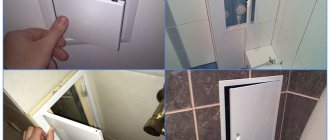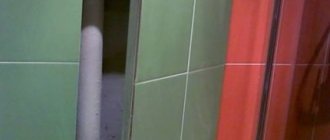Surely many of us have faced the difficult task of how to eliminate the smell from the sewer in the bathroom and toilet. After all, these characteristic “aromas” threaten not only with the occurrence of unpleasant sensations, but also pose a significant danger to the health of residents. Usually they are nothing more than a mixture of methane vapor, ammonia, hydrogen sulfide, and other harmful substances. Such chemical compounds, concentrating in sewer pipes, tend to penetrate into living spaces at the slightest opportunity. This opportunity often arises as a result of violations of the rules for operating drain lines or as a result of accidents on them.
However, the reason for an obsessive foreign odor in toilets, bathrooms or kitchens does not always lie in the malfunction of the sewerage elements. Therefore, in order to find the right approach to eliminating the source of an unpleasant olfactory irritant, you should accurately determine its nature. Let's take a closer look at the possible causes and methods of solving this problem.
What harm can it cause to health?
Usually people believe that the smell from the bathroom in the house brings nothing but discomfort. But this is not so, because household members inhale vapors of ammonia and hydrogen sulfide. There are methane impurities in the air. Inhaling toxic fumes every day, residents suffer from nervousness, they experience anxiety, restlessness, and irritability for no reason.
Mold develops on the walls due to dampness. Fungi enter the human body, causing the person to get sick. He develops pathologies of the respiratory organs and gastrointestinal tract. Staying in the room for a long time will lead to serious poisoning. Prolonged exposure to methane has a negative effect on the autonomic system of residents, which produces a nervous tic in the eye area. And oxygen starvation of brain cells causes weakness, nausea, dizziness, and a drop in blood pressure.
Construction of the drainage system
The components of the sewer system include:
- pipes of various diameters necessary to drain water from the bathroom;
- ventilation and sewage risers;
- pressure manifold;
- water drainage lines.
Not only the bathroom, but also the shower room is connected to the system in a private house. The lowest point of the system is the wastewater outlet. A ventilation valve is installed on the top. This point is located above all water intake nodes. The functions of the valve include sealing the system so as not to allow harmful gases and odors to enter the room.
All outlets of the system into the collector are connected to the lower point ending with the siphon. This includes a bathroom and shower. All pipes must slope towards the collector well. An ideal sewer system does not have sharp turns of 90 degrees, and there are no changes in height within one branch.
The main causes of unpleasant odor
A foul cocktail of germs leaks into your bathroom for a variety of reasons. They are hidden in the appearance of cracks in pipes, malfunctions in the sewer and ventilation systems.
Design errors
Self-installation of sewerage leads to the fact that the system begins to work incorrectly. If there is an error in design and installation, a fan ventilation riser in a bathroom allows odors into the house due to the failure of the water dispenser. If the installation of sewer pipes does not start from the lowest point, then malfunctions will occur in the form of wastewater leaks.
See also
How to get rid of unpleasant odor in the toilet, TOP 20 best remedies and methods
Wrong angle
Pipes must be laid with a slope, the angle of which depends on their diameter. If this is not done, the water will stagnate and leakage will occur. The smells of rotting will spread throughout the apartment.
Incorrect siphon operation
Blockages and icing of pipes lead to the fact that stagnant air will put pressure on the siphon. Gas bubbles come out, hence the stench throughout the apartment. The reason for the increase in pressure is that the diameter of the pipes is chosen incorrectly.
Leaks
Rigid fastening of pipe joints ensures their tightness. But as soon as cracks form at the joint, dampness and stench appear.
Ventilation problems
Proper installation of the ventilation riser will not allow air to stagnate in the bathroom. Mustiness and dampness will go away if you clean the ventilation system shaft in time.
Blockages
Plugs in pipes occur as a result of debris, hair, and wool getting into them. Dirty bathroom drains will not be able to pass through narrow passages. This creates a traffic jam, which causes unpleasant odors in the house.
Eliminate odor in the toilet or shared bathroom
A toilet installed in a bathroom can also have a significant impact on the air quality in the room, which is especially noticeable when its normal functioning is disrupted. Therefore, in an integrated approach to finding and eliminating the causes of unpleasant “odors,” we do not forget about inspecting the plumbing of the latrine.
- The first step is to check the integrity of the toilet outlet and the place where it connects to the sewer outlet. Perhaps there is a leak that requires replacement of the sealing collar or treatment with a sealing compound. The event will not cause any particular difficulties if the plumbing fixture is connected to the sewer using a corrugated connector. But if the interface is rigid, then the toilet will first have to be dismantled.
- Inspect the drain tank - where it sits, where the water supply hose is connected, and the condition of the tank. Cold water, especially in winter, causes condensation to form on the outer surfaces of the tank. Collecting into drops, it flows under the toilet, forming puddles. Constant dampness favors the development of mold and bacterial colonies.
Removal of unwanted microflora is carried out with detergents and disinfectants. In addition, good ventilation is a good way to prevent moisture stagnation. - It also happens that behind communication pipes in an inaccessible place there is a forgotten rag or sponge. Once saturated with water, they slowly rot, poisoning the atmosphere of the bathroom.
How to find the source of the problem
Many of the causes of bad smell in the bathroom can be eliminated on your own. But to do this, they establish why and where the dampness and stench came from.
Checking the operation of the ventilation system
A piece of paper is placed against the bathroom ventilation grill. If it deviates inward, then the internal thrust is normal. You can also check the operation of the system using a lit match or candle or lighter. The flame should rush into the ventilation shaft.
Checking the sewer system
The next step involves checking all sewer pipes. Use a napkin to go over those places where leakage is possible. It could be burst pipes. Detected leaks are a source of mold and odor in the bathroom. Incorrect slope is detected using a level. Then check the drain in the sink.
Checking the sink and bathtub
The fact that the sewer is clogged can be determined by how the water flows out of the bathroom and sink. To do this, open the taps at full power and watch the drainage. Slow drainage of water indicates problems.
Inspection of joints of sewer system elements
Smells of rotting come out of pipes at their junction quite often. The fastening weakens over time. And cast iron pipes begin to rust at the joints, which leads to depressurization.
Are the pipes laid this way?
Sewer smell in the bathroom: what are the causes and how to eliminate it
If the toilet smells like sewage (or in another room), first, inspect the pipes to find out whether the installation of the system was done correctly. There are established building codes that clearly outline the location of each pipe.
Note! Even a slight deviation from the standard angle of inclination will cause stagnation of wastewater, which, naturally, will begin to stink over time. Eliminating this cause on your own is unrealistic - dismantling of the pipes is necessary. This cannot be done without involving a utility service.
Options for solving the problem
Correcting the situation with pipes in a timely manner will freshen the air not only in the bathroom, but throughout the entire house. There is no point in escalating the problem, as it can have a negative impact on the health of your household.
Improved traction
There are several ways to get rid of bad smell in the bathroom by increasing the draft of the ventilation system:
- Blockages in the shaft are removed using an installed fan. It turns on automatically, spraying particles of dust and dirt.
- The air lock in the ventilation is removed by opening the bathroom doors at night.
- Objects that fall into the shaft are lifted with a special device, shining a flashlight.
- The axial model fan is installed on the ceiling.
- Holes are made at the bottom of the door to allow air to circulate in the bathroom.
See also
TOP 14 methods on how to quickly get rid of the smell in an apartment after grandma
These actions are often enough to remove unpleasant odors.
Cleaning
Sewer clogs can be removed in different ways. Either special devices or chemical concentrates should be used. Sometimes you can get by with simple means.
Mechanical
To remove blockages in bathroom pipes, you need a plunger. They close the drain hole. Then fill the bathtub or sink with water so that it covers the bottom of the plunger cap. Then move the elastic cap up and down.
If after the procedure the water begins to flow quickly, then the blockage has been eliminated. Otherwise, repeat the operation several times.
For metal pipes, cleaning with a cable will be effective. Pass the metal product inside the hole and push it further with clockwise rotational movements. A cable can be used to remove the plug from debris and dirt. After this, hot water is poured into the hole to break down the fatty deposits in the pipes. The cable is washed with soapy water, wiped dry, lubricated with machine oil and stored in a dry place.
If there are no devices at hand, then unscrew the siphon or pipe, remove the stuck debris, and wash with soapy water.
Folk remedies
Odors of ammonia and mold are removed from sewer pipes in the bathroom using improvised means. Every housewife has substances that can remove blockages in pipes.
Salt
Place 3 tablespoons of salt in a glass of hot water. Pour the solution into the bathtub hole and leave overnight. You can pour salt into the drain and pour boiling water on top.
Soda and vinegar
A mixture of baking soda and acetic acid can help eliminate stench caused by clogs in your drainage system. The substances break down layers of dirt and grease on the inside of pipes. They are taken in equal quantities and the pulp is placed in the drain. Then pour hot water. After 2-3 hours, a fresh smell appears in the room.
"Alka-Seltzer"
Anti-hangover tablets work well in clearing clogged pipes. Throw 2 tablets of the drug into the hole in the bathtub or sink. A glass of vinegar is poured in there. Rinse with a stream of water after 5 minutes.
Mustard
For strong odors in the bathroom, you can use mustard powder. Pour the substance into the drain, and then hot water on top. Within 10 minutes the water drainage will be restored.
"White"
Chlorine-containing liquid is suitable for combating blockages in the sewer system. You need to pour the solution into the hole. After 20 minutes - hot water. And the smell will disappear, the drain will work quickly.
Professional products
When improvised means cannot cope with cleaning pipes, then strong concentrates come to the rescue. They are based on acids and alkaline compounds that break down pollution.
"Domestos"
The product is used not only for cleaning tile products, but also for gutters and drains. As part of Domestos:
- sodium hypochlorite, which disinfects and degreases surfaces inside pipes;
- Surfactants that help the product dissolve better;
- soap for disinfection;
- fragrances that muffle unpleasant odors.
Dilute 50 ml of the product in 5 liters of water or use undiluted.
See also
20 best remedies on how to remove and remove urine odor forever
"Mole"
One of the best clog removers consists of sodium and potassium hydroxide. The filler is a chemical acid. Krota substances can dissolve and break down any deposits in pipes. Pour 200 ml of cleaning liquid into the drain hole. If powder is used, then it is poured and filled with hot water in the amount of 2 glasses. After 1.5-2 hours the product will take effect. All that remains is to flush the system with water.
"Tiret"
A concentrated liquid with a pungent odor quickly cleans plumbing drains. 250 ml of product is poured into the pipe. After 5-15 minutes, repeat the procedure, taking 100 ml of thick gel. Then pour 2 liters of hot water into the sink. After this procedure, the blockage will disappear. Cleaning is carried out wearing rubber gloves, protecting the respiratory system with a mask and eyes with goggles.
"Steril"
The disinfectant is a white powder. The working solution is prepared at 1 or 2% before the sewer cleaning procedure. It is poured into the sink hole and left for half an hour. Finally, rinse with warm water.
"Pothan"
The chemical is used to clean plumbing pipes. Since the substance emits dangerous gases, safety precautions should be followed when using the product. It contains about 30% caustic alkali.
The advantage of the drug is its effectiveness and rapid action. In just 3 minutes the blockage will be cleared.
"Mister Muscle"
Get rid of hair and dirt, remove unpleasant odors - the drug can do all this. Foam or gel is poured into the pipes, then the system is washed with warm water. It is necessary to work with gloves, trying to prevent the liquid from getting on the skin.
Prevention measures
Sewage odors can be avoided (or minimized) if you adhere to the following basic rules:
- Special grates are installed on sink, sink, and bathtub drains to prevent large, dense fractions from leaking into the sewer system;
- Shredders that turn waste into dust will help avoid pipe blockages;
- you need to constantly monitor the condition of the water seal, preventing the siphon from drying out and becoming clogged;
- When going on vacation, it is recommended to pour a little oil into the drain holes - it will form a film that will prevent the water seal from evaporating and prevent unpleasant odors from penetrating into the apartment.
Note! The oil film can be easily removed by washing the drain hole with dishwashing detergent.
In order not to smell odors from the toilet room, they can be interrupted by other, more pleasant aromas. In the bathroom you can hang gauze bags with tea leaves or ground coffee beans, place scented sachets on the shelves, or use air fresheners.
Sealing sewer joints
Often pipes begin to leak at the joints. Work needs to be done to correct the problems. Using fum tape will help eliminate leaks temporarily. Therefore, it is better to use a sealant.
Silicone
One of the best types of sealant will help hold the pipes together firmly. They will last a long time if the joints are lubricated with silicone. The compositions do not shrink and retain their properties even with sudden temperature changes.
Acrylic
Although such sealants have low elasticity, they will last a long time. Their advantage is their ability to repel water. They adhere to joints at any temperature.
Silicone-acrylic
Sealants are used not only at pipe joints. They “treat” cracks, chips, and seal seams in areas of the plumbing system.
Polyurethane
Apply sealant to the damaged area with a spatula. When it dries, the system is started. Polyurethane sealant takes paint well.
The pipe leaked
Sewerage laying
Over time, sewer pipes become unusable and leak. In some cases, it can be noticed immediately and quickly eliminated. But there are defects that are not visible to the naked eye, or the pipes are located in a place inaccessible to inspection - under a bathtub or shower stall, hidden in panels or covered with furniture.
Even on a pipe that is open to view, you will not immediately notice a crack if it is located on the side facing the wall or floor. Here you will need to probe all the sewer pipes manually using paper napkins. To do this, you will have to move furniture, open panels, etc.
The pipe leaked
If a defect is discovered, you should not try to repair it. Also, you should not change only one section of the system - it is better to completely replace all metal pipes with more modern plastic that is resistant to corrosion.
Important! It is better to keep the number of joints on pipes to a minimum - they can also cause leaks (here you will need a good sealant).

